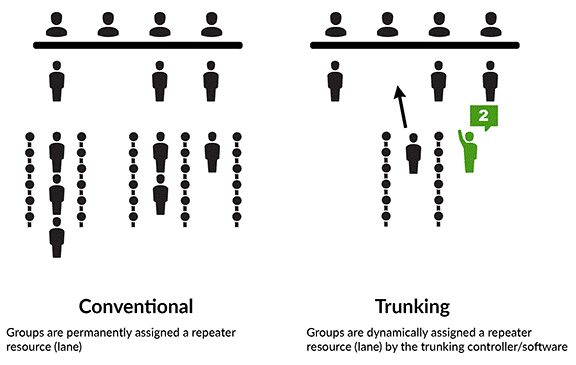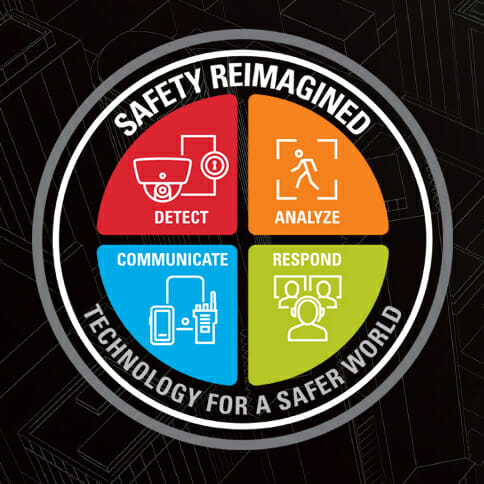We checked in with a few of our Motorola two-way radio experts to get some key indicators of when it could be time to upgrade to a higher-capacity, trunked radio system such as Motorola Capacity Plus or Capacity Max.
If your organization is experiencing growing pains with its two-way radio system and you are considering whether to upgrade to a newer or higher-capacity system, you aren’t alone. If you are asking yourself, Why am I getting busy signals? Why do I have to make multiple calls to reach all my users? Or, why am I hearing all of these irrelevant conversations? These could be indications your organization needs a trunked radio system.
But when is it practical or necessary to upgrade? Here are some of the considerations when looking into a radio system expansion or upgrade.
What is Trunking?
A common analogy between a conventional vs a trunking system is standing in line at a bank. In one example (conventional) you have four bank tellers, and four individual lines you can stand in. In the other example (trunked) you have four bank tellers, but this time you have a single line, with an attendant at the front of the line letting you know which teller is available.
Trunking is an advanced alternative where channels are automatically selected based on availability by a computer-based system. With trunking, talkgroup users are dynamically assigned to a repeater, and the system automatically broadcasts to anyone in that group, increasing efficiency and reducing wait time for radio users. Conversely, in a conventional system, you may be stuck in the “wrong line” so to speak, and there is no way for you to utilize the open repeater resource. That’s where you would experience the busy signal “bonk”.
Since its highly unlikely radio users will transmit on all channels at all times (really how could you get anything done) we are able to share this resource more efficiently with trunking. Simply put, trunking significantly increases the capacity of your radio system, meaning more talkgroups and users can effectively access the repeaters on your radio system.
Using the same number of repeater resources, MOTOTRBO Capacity Plus/Capacity Max (trunking) has:
- 5x the capacity of conventional analog
- 3x the capacity of analog trunking
- 2x the capacity of MOTOTRBO conventional digital
Next, we’ll look into some indicators of when trunking may be necessary.
Trunking Upgrade Indicators
Now that we’ve covered the basics of trunked radio systems, if you are experiencing any of these issues, it could be a sign you need a trunking system.
- Consistently getting busy signals
- The person you need to reach isn’t on their “home” channel, and can’t be found
- Getting interference from other radio systems
- Finding it very expensive to increase capacity with current system
- Have to repeat calls on different channels so all users receive your message
- Your radio fleet is growing and you now have more than 100 users
- You have security/privacy concerns
Benefits of Upgrading to Trunking
A trunked radio system may seem like it would resolve your major communication system pain points. Let’s look at some of the many benefits it provides:
- Trunked systems with specific work groups (Talkgroups) help ensure communications get to the right people and get heard
- Calls sent to Talkgroups are only heard by people who need to hear them
- All Call: get critical messages through to all users
- Radio operation is much easier/more intuitive for the end user
- Helps with facilitating emergency plans–get verbal confirmation in seconds
- Interoperability with partners and vendors on larger projects
- Provide more capacity with less equipment and lower total cost of ownership
- Expanded (GPS) location tracking capacity–provides more accurate location data without tying up voice channels
- Private call, text, call alert, and radio check all work in Capacity Plus or Capacity Max regardless of channel (in conventional system the caller needs to know what channel they are on)
- Better control and security–available remote disabling of missing or rogue radio units
- Increased system uptime–capability to use all system repeaters for failover or redundancy
- Capacity to evolve to continue meeting future needs
Capacity Limitations Impact Revenue
Upgrading your radio system may be low on the list of priorities because it is not seen as a revenue generator. However, a conventional radio system may be costing your organization time, resources, safety, or outright cash flow.
In urgent scenarios, every second counts. If production goes down you are losing money every minute you are offline. When lives are at risk, reaching the right people as soon as possible could mean the difference between life or death.
Additionally, trunked systems offer the capability of upgrading to integrated security platforms such as Motorola’s Safety Reimagined, which allows voice and security systems to work together to alert the right staff member in closest proximity to quickly address emergency scenarios before they escalate in risk or cost.
Productivity impacts your bottom line when extra time spent in communicating is added up over months and years.
What is Involved in Trunking Upgrades?
You may find that you already have a lot of what you need for a radio trunking upgrade. Lots of existing radio equipment is compatible with trunking systems, so the expense of upgrading might not be as bad as you think. Some will find they only need software upgrades, licensing, and reprogramming to add trunking to their radio system.
Some considerations include:
- Adding additional repeaters (although fewer are needed to expand capacity over conventional radio systems)
- Space, rack, and power requirements
- Radio Frequency (RF) Combining equipment
- FCC Licensing changes
- May or may not need to buy new/more radio units
- Purchase of Motorola software that enables trunking features
Even if significant hardware and infrastructure upgrades are necessary, the improved efficiencies, safety, and user experience may be worth the investment.
Do you have additional questions? Talk to us to continue exploring whether trunking is a good fit, what system upgrades we recommend for your specific needs, and what it would take to get you there. We are happy to help!


